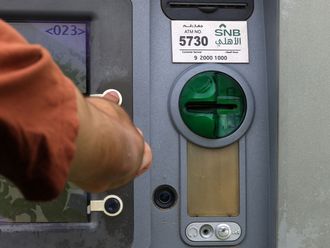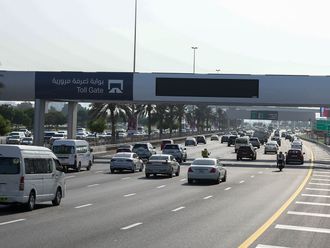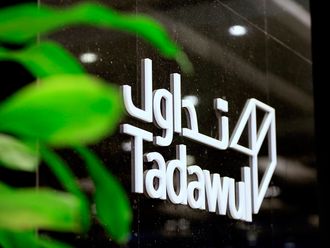
Unlike some of its immediate neighbours burdened with heavy foreign debt, Syria's economy has an edge. It has relatively low debt one of the lowest among the Arab countries.
It also has another advantage: high foreign exchange reserves.
However, Syria's economy has other challenges to face as a result of its current movement through a "transitional phase", economic experts say.
"We are a transitional economy, moving from a command economy to a market economy," Nabeel Sukkar, founder and manager director of The Syrian Consulting Bureau for Development and Investment (SCB), added.
"Why [do] we want to move to a market economy?" Sukkar asked Gulf News. "Because a market economy leads to more efficiency in allocating resources."
Therefore, challenges ahead include taking necessary steps to move into a transition market economy, define the starting point, and identify the needed steps to transform an economy that is based mainly on agriculture and industry.
Syria started its economic reforms in the second half of the 1980s. Though the reform steps were slow and blunt at the beginning, they gained momentum at a later state. Reforms received a new push when President Bashar Al Assad took control in the late 1990s.
The 1980s were, for many developing countries, the "lost decade", experts noted.
"Many hopes were pinned on [during that time], but these hopes were lost," Abdul Qadir Nayyal, A Damascus-based commentator and expert, said. "Debts were accumulated in all developing countries," he added.
However, for Syria the situation was less painful, as the country didn't need to borrow on a large scale, and the relatively soft conditions in bilateral agreements reached between Syria and other countries, most of them lenders, lessened the impact of the debt problem on the economy, Syrian experts noted.
New minister
As economic reforms in Syria are expected to continue, Al Assad appointed Lamia Al Assi as the new minister for Economy in the country.
Today, agriculture and industry constitute the backbone of Syria's economy, economic experts say.
Among the positive elements of the economy, of the country with a population of nearly 20 million, is that the foreign debt is "very, very low", experts and reports noted.
Syria ranked number 9 among 13 Arab countries in terms of the size of its external debts, a recent Arab Economic Report showed. The Middle Eastern country's foreign debt reached $5.294 billion (Dh19.42 billion) in 2008, up from $5.137 billion in 2007 and $ 4.1 billion in 2003, according to a report prepared by the Arab Monetary Fund in 2009 that was published earlier this year. The top five Arab countries with foreign debts are Sudan, with nearly $33.6 billion, followed by Egypt with $32.1 billion, Lebanon with $20.8 billion, Tunisia with $20.5 billion and Morocco with $17.3 billion, the Arab Monetary Fund added.
The same report noted that the servicing of Syria's external debt in 2008 reached $675 million.
"We have also another good element, which is the foreign exchange reserves, which is quite high. We have around $17 billion in foreign exchange reserves," said Sukkar, whose long monetary and financial experience includes being a macro-economist and a financial analyst with the World Bank in Washington, DC.
Apart from natural resources, the "Syrian people have the ability to adapt and cope with the changes and with a pragmatic mentality," Nayyal said.
Today, Syria has "a well-diversified economic base", where industry, agriculture and trade constitute its backbone.
Historical role
Throughout history, Syria has had an important role to play in the regional trade and agricultural products.
The country, as the seat of the Ummayed caliphates, was known for trade and cultural heritage. Natural resources and agriculture continue to nourish the modern state of Syria.
Of Syria's 72,000 square miles, roughly one-third is arable, with 80 per cent of cultivated areas dependent on rainfall for water, experts noted.
The small shops in the old city of the capital are stuffed with local products, ranging from dried fruits, fresh nuts and baked Arabic sweets to the famed embroidered table-cloths and well-finished furniture pieces decorated with mother-of-pearl.
Though economic reforms and ambitious development projects have been under way since the 1990s, the reforms are being "slowed by large numbers of poorly performing public sector firms, low investment levels, and relatively low industrial and agricultural productivity", an economic report said.
However, prominent Syrian experts dismiss this assessment. "It is not fair to say that," Sukkar said. "You need to introduce reforms to improve all the constraints you have mentioned. But you can't say that the reforms have been slowed down by these factors. The reforms are intended to upgrade all these factors," he added.
Sukkar continued: "But these are the kinds of issues that we should encounter as part of the capacity building."
Necessary step
Boosting the competitive advantage of Syrian industries and markets in the face of other markets is a necessary step before "heavily" liberalising Syria's industries, lowering duties and expanding the size of the country's exports.
Other reforms, including institutional development, educational reform and judicial system reforms are also required.
"Reforms [are] intended to accelerate all these things," Sukkar said, referring to public firms' performance, investment levels, and industrial and agricultural productivity.
One of the major challenges that Syria needs to tackle, according to experts, is achieving a rate of growth that is sustainable and high enough to absorb the existing unemployment and new entries into the labour market, experts say.
With nearly 60 per cent of the population under the age of 20, Syria has a major challenge of unemployment.
The International Monetary Fund (IMF) is projecting a growth of 4.2 per cent in 2010, while the Syrian government has announced a growth of 4.5 per cent for 2009.
While the percentage seems high, experts warn that the figure looks very good but not for developed countries.
However, for developing economies, "It is not good. You expect developing countries to grow much faster to try to catch up," Sukkar said. Higher growth rates can be achieved by moving to a market economy and achieving high rates of investments, increasing productivity of investments.
Foreign direct investments (FDI) in Syria reached $2.1 billion in 2008, compared to $1.2 billion in 2007, as reported by the United Nations World Investment Report 2009.
It is believed that the world economic slowdown has adversely impacted the flow of investments in 2009.
"Sectors like industry and agriculture should be given more attention," Nayyal said, after the monetary and financial sectors received the lion's share of attention.
- $5.2b Syria's foreign debt in 2008
- $17b amount the country has in foreign reserves
- 60% of the population is under the age of 20












